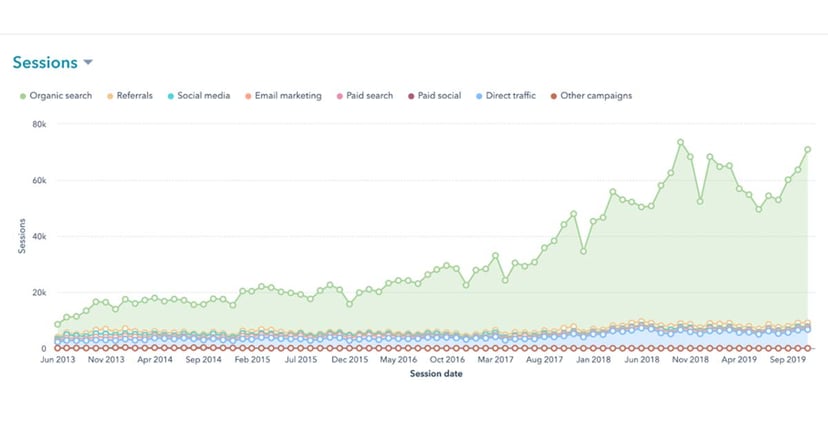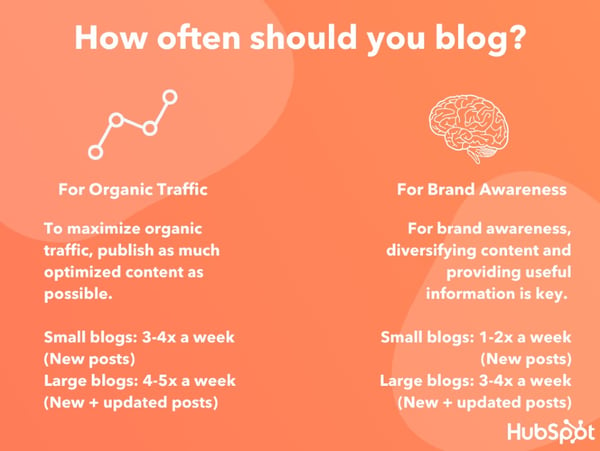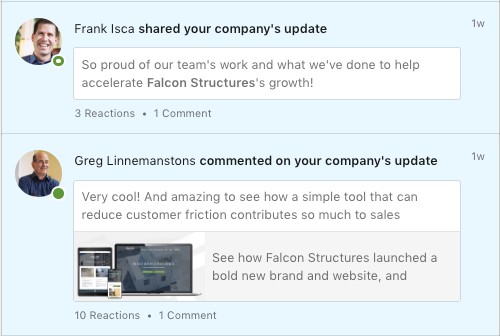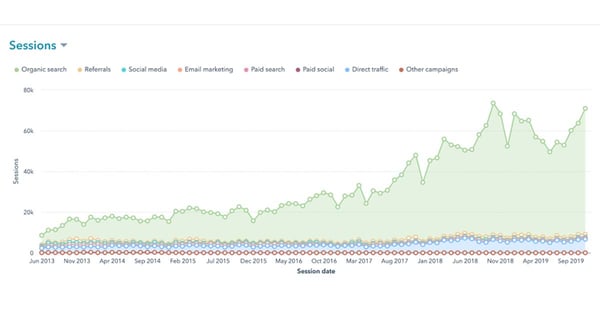How Often Does Hubspot Post To Their Blog
"How many blog posts per week does it take to generate traffic?" It's a question every B2B content marketer asks and wants answered — especially when they are responsible for generating articles within a company just embarking on the blogging journey. A logical follow-up question is "How long does it take to see results? Weeks? Months? Years?" The universal answer to these questions, of course: it depends. (But if your boss is asking, tell him not to expect a flood of new contacts and traffic tomorrow.) I don't mean to sound glib. However, gaining traction with content publication is a lot like scaling a mountain. You probably won't reach the summit in a day but you will eventually, provided you're committed to a slow and steady climb. Commonly, blogging for at least 12-18 months is necessary before you can fully assess its effectiveness on increasing website traffic and attracting/converting new lead opportunities. Based on industry data, the Weidert Group's experience with our own blog and those we have a hand in launching for our clients over the past nine years, we've concluded there is a definite tipping point once you consistently publish a certain number of blog posts per week. We've also identified five factors that influence exponential traffic growth: Website Integration and Calls to Action Consistent Publishing Frequency Content Quality Social Media Activity Competitors' Blogging Activity In an ideal world, your blog should be directly integrated within your main website content management system (CMS) so it lives within your website's core domain. This helps your website build authority with search engines since every new blog article counts as an indexed page filled with searchable content. Insights from tools like Google Search Console will help you stay on top of key metrics surrounding your page indexing. Alternately, and to the chagrin of some SEO experts, you could have your blog live on an external platform with a subdomain such as blog.yourwebsitedomain.com. Set-up is often easier, but since this new subdomain has no previous content authority with search engines, you're essentially starting from SEO scratch. In this case, expect things to take longer with securing favorable Google rankings, but be diligent in doing everything you can to help your website show up in search results. Whichever domain route you choose, it's key that blog visitors can easily access your core website pages, whether that be through the main website navigation still appearing when viewing a blog, or strategic use of calls-to-action (CTAs) that direct blog visitors to specific pages of your website. Google — and humans who frequent your website and/or blog — love content sources that are consistent with their publishing frequency. In order to build your credibility and traffic, choose how often you will post articles (daily, weekly, bi-weekly, etc.) and stick to the schedule. The decision on frequency is so important, in fact, that HubSpot created blogging frequency benchmarks to help small and large businesses target the most realistic publishing cadence: Source: HubSpot, How Often Should You (or Your Company) Blog? A daily or weekly blog frequency is only going to help you increase your traffic if the content is unique, thoughtful, and helpful to your readers. When creating any type of content it's always better to follow the rule of quality over quantity, as long as you're not posting only one blog article per month. Developing quality content starts as early as identifying buyer personas within your inbound marketing strategy. Knowing the ideal person person who would be reading your blog will help you tailor content that resonates with their pain points, needs, and possible solutions. This will also help you form a content strategy that includes topic areas that position you as relevant and a potential thought leader within your industry. Great online content goes unread every day, largely due to lack of promotion. Companies that take a team approach to promoting their content on social media channels see a dramatic increase in attracting additional traffic — especially when you're consistent about it! On a similar note, don't feel like you can only promote a blog article once. If a particular post is really popular with your readers on LinkedIn, for example, share it again on LinkedIn a week or two later on your personal profile or in a different LinkedIn group (in a helpful, non-spammy way, of course). And don't ignore the other social media platforms! Shape the content for maximum sharing on Facebook, Twitter, Instagram, and SnapChat. If you're lucky, you might be the only one in your industry taking on blogging. If so, you'll attract a lot more attention and traffic, especially if you set a high standard on the quality level of content you publish from the start. If your competition is already blogging it's up to you to outpace them with better content, published more frequently and better promotion on the right social media channels. Sound like a challenge? It can be, but it can also be a true point of differentiation if you arm yourself with a well-defined inbound marketing competitive review that drills into SEO and market positioning. At Weidert Group we've been blogging since April 2011, which gives us many years of quality blog posts. Launching our blog, though, wasn't sunshine and roses out the gate. It took years of hard work and content creation to earn the success we enjoy today — including publishing a blog every business day for the first many years. We rarely missed that goal. As a result, we amassed a wealth of quality content and were able to retool our approach to publishing frequency. We now post a combination of new and optimized articles two- to three times per week. But as I mentioned, it didn't happen overnight. In our first 13 months of blogging (April 2011 to April 2012), months 5, 10, and 13 were the first ones in which we saw a tipping point of exponential traffic growth, as reflected in the following charts (Green = organic search traffic, Yellow = referral traffic, Turquoise = social media traffic, Orange = email traffic, Blue = direct traffic). The number of blog articles published during each of these tipping point months were as follows: Month 5 = 77 total blog articles Month 10 = 150 total blog articles Month 13 = 215 total blog articles Our Month 5 blog total is consistent with what we've seen with our clients, and with that others in our industry report with regard to their clients' results. Qualitatively speaking, reaching 55 to 70 consistently published blogs appears to be a trigger for Google to deem a content source as legitimate, and increased traffic/rankings follow. In our overall blogging journey, there are clear milestones where we benefited from Google algorithm updates that favored websites with high levels of original and helpful content created for actual users (versus content created for Google's algorithm). The real key to this kind of traffic growth, though, was dedication and consistency that resulted in nearly 900 individual blog articles. As nice as it would be to have a "magic number" of blog articles to target for exponential traffic growth, every company and industry is different. The best strategy is to reach that 55-70 total blog article range as quickly as you can with high-quality content and consistent publishing schedule. 
Factors That Impact Getting Website Traffic From Your Blog
1. Website Integration & Calls-to-Action
2. Consistent Publishing Frequency

3. Content Quality

4. Social Media Activity

5. Competition in Your Industry
The Blogging Tipping Point
Overall Website Traffic (first 13 months of blogging)

Organic Search Website Traffic (first 13 months of blogging)

Overall Website Traffic (June 2013 – November 2019)


Topics: Content Marketing, Starting an Inbound Program
How Often Does Hubspot Post To Their Blog
Source: https://www.weidert.com/blog/how-many-blog-posts-to-grow-traffic
Posted by: simmonsshavinicaut.blogspot.com

0 Response to "How Often Does Hubspot Post To Their Blog"
Post a Comment